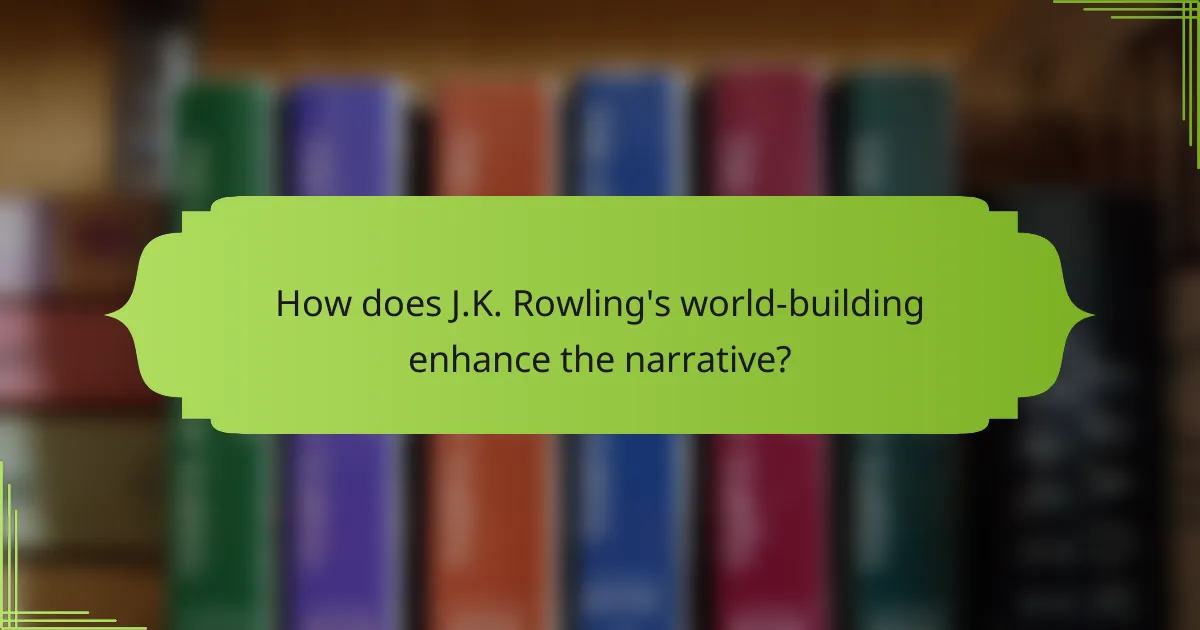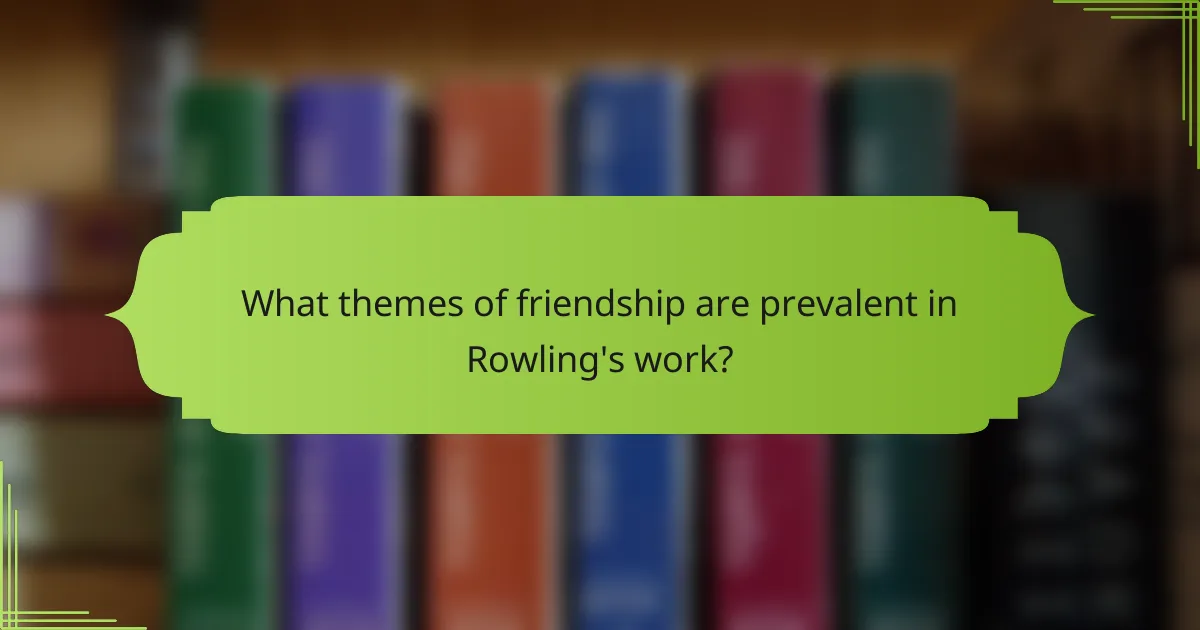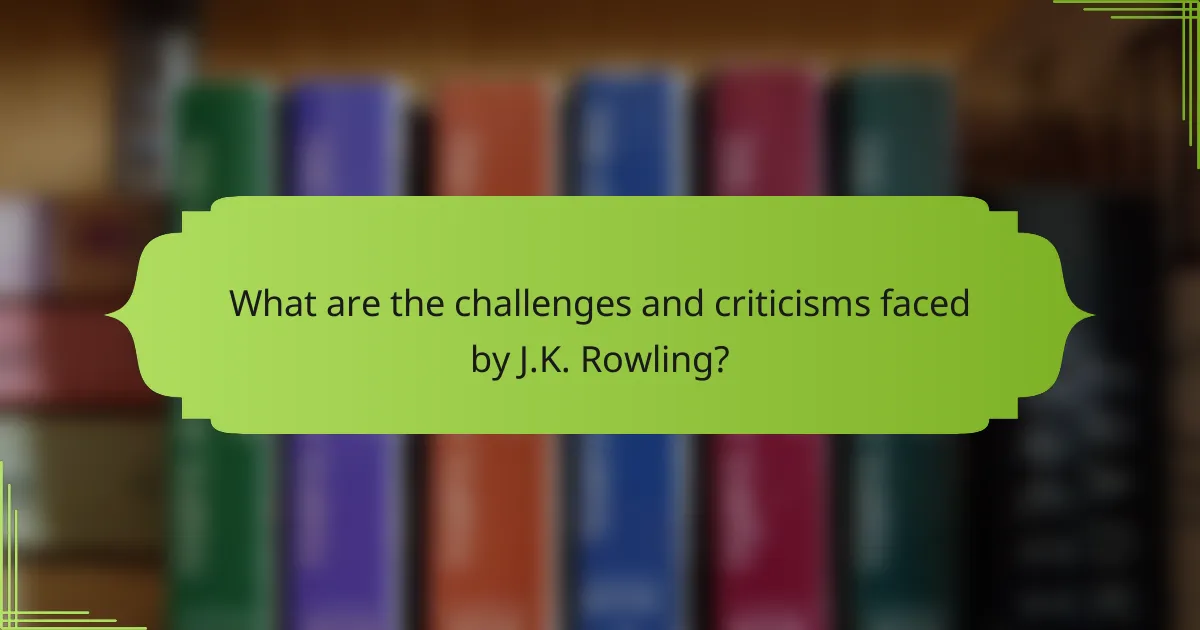J.K. Rowling’s work captivates readers through immersive world-building, relatable themes of friendship, and significant cultural impact. Her detailed settings, like Hogwarts, enhance character interactions. The bonds between characters, particularly Harry, Ron, and Hermione, illustrate loyalty and resilience. Additionally, Rowling’s narratives have influenced literature and sparked global discussions on social issues.

How does J.K. Rowling’s world-building enhance the narrative?
J.K. Rowling’s world-building significantly enhances the narrative by creating a rich, immersive universe. The detailed settings, such as Hogwarts and the wizarding world, add depth to character interactions and plot development. Rowling’s unique attributes, like the intricate magical system and diverse magical creatures, foster a sense of wonder and exploration. This world-building supports themes of friendship and bravery, allowing characters to grow in meaningful ways. Additionally, the cultural impact of her work has led to a global community, further enriching the narrative experience through shared connections among fans.
What are the key elements of Rowling’s magical world?
J.K. Rowling’s magical world features rich world-building, profound themes of friendship, and significant cultural impact. Key elements include a detailed magical system, iconic characters, and a blend of fantasy with relatable human experiences. The setting, primarily Hogwarts, serves as a backdrop for exploring loyalty, bravery, and the importance of choices. Rowling’s influence extends beyond literature, shaping popular culture and inspiring a generation through her narratives and moral lessons.
How does the setting influence character development?
The setting significantly influences character development by shaping their experiences and interactions. In J.K. Rowling’s world, the magical environment of Hogwarts provides unique challenges and opportunities that foster growth. For example, friendships formed in this setting highlight themes of loyalty and bravery. The diverse cultural backgrounds of characters enrich their perspectives, enhancing their development throughout the series. The interplay of setting and character shapes readers’ understanding of identity and belonging.
Which cultural references shape the world of Harry Potter?
Cultural references shaping the world of Harry Potter include mythology, folklore, and British history. J.K. Rowling draws from diverse sources, enriching the narrative with familiar themes. For example, the use of mythical creatures like hippogriffs and centaurs reflects ancient legends. Additionally, elements like Hogwarts’ houses parallel traditional British school systems, enhancing relatability. The series also incorporates moral lessons, mirroring classic literature and fairy tales, underscoring themes of friendship and bravery. These influences contribute to the rich tapestry of the Harry Potter universe, making it resonate globally.

What themes of friendship are prevalent in Rowling’s work?
Themes of friendship in J.K. Rowling’s work include loyalty, sacrifice, and the importance of chosen family. Characters often face challenges that test their bonds, emphasizing trust and support. For example, Harry, Ron, and Hermione exemplify unwavering loyalty, overcoming obstacles together. Their friendship highlights resilience and the transformative power of companionship.
How do friendships evolve throughout the series?
Friendships in the series evolve through shared experiences, challenges, and personal growth. Initially, characters like Harry, Ron, and Hermione form bonds based on mutual support. As the series progresses, these friendships deepen through trials, betrayals, and sacrifices, highlighting themes of loyalty and resilience. The transformation of relationships, such as the complexities between characters like Draco Malfoy and Harry Potter, showcases unique attributes of friendship, illustrating how understanding and empathy can reshape dynamics. Ultimately, these evolving friendships reflect broader themes of community and belonging within Rowling’s world-building.
What role do loyalty and sacrifice play in relationships?
Loyalty and sacrifice are essential in relationships, fostering trust and commitment. In J.K. Rowling’s works, characters often demonstrate these qualities, enhancing themes of friendship. For example, Harry Potter’s loyalty to his friends leads to profound sacrifices, illustrating the impact of these virtues. Such dynamics resonate culturally, reflecting real-life values that strengthen bonds.
Which characters exemplify the theme of friendship?
Harry Potter, Hermione Granger, and Ron Weasley exemplify the theme of friendship in J.K. Rowling’s work. Their bond showcases loyalty, support, and bravery throughout the series. Each character represents unique aspects of friendship: Harry’s courage, Hermione’s intellect, and Ron’s loyalty. Together, they navigate challenges, highlighting the importance of collaboration and trust. This dynamic reinforces the cultural impact of friendship as a central theme in the narrative.

How has J.K. Rowling’s work impacted popular culture?
J.K. Rowling’s work has profoundly influenced popular culture through its imaginative world-building and themes of friendship. The Harry Potter series has shaped literature, film, and even education, inspiring a generation of readers. Characters like Harry, Hermione, and Ron exemplify loyalty and bravery, resonating with audiences globally. The franchise has generated over $25 billion in revenue, indicating its cultural significance. Rowling’s impact extends to social issues, as her narratives often address themes of prejudice and acceptance, fostering discussions on diversity and inclusion.
What are the significant adaptations of her work in film and theater?
J.K. Rowling’s work has been significantly adapted in film and theater, enhancing its themes and cultural impact. The Harry Potter film series brought her world-building to life, showcasing the intricate details of the wizarding world. The films emphasized friendship through character development and relationships, aligning with the original narratives. Additionally, stage adaptations like “Harry Potter and the Cursed Child” introduced unique storytelling techniques, expanding on the original characters and themes. These adaptations have contributed to a broader cultural phenomenon, influencing generations and fostering a global fanbase.
How do fan communities contribute to the cultural legacy?
Fan communities significantly enhance the cultural legacy of J.K. Rowling’s work through shared experiences and collective creativity. These communities foster deep connections among fans, encouraging engagement with themes of friendship and loyalty present in the narratives.
Moreover, fan-generated content, such as fan fiction and art, expands the universe, offering unique interpretations that contribute to its richness. Events like conventions and online discussions further solidify these bonds, creating a vibrant cultural ecosystem that celebrates Rowling’s storytelling.
The impact of these communities is evident in their ability to sustain interest in the franchise over time, influencing new generations of readers. This ongoing dialogue and creativity ensure that the cultural legacy of Rowling’s work continues to evolve and resonate.
What influence has Rowling had on contemporary literature?
J.K. Rowling has significantly influenced contemporary literature through her innovative world-building, themes of friendship, and cultural impact. Her creation of the Harry Potter universe introduced readers to a richly detailed magical world, fostering imagination and engagement. The themes of friendship and loyalty resonate deeply, encouraging readers to value relationships. Rowling’s work has also sparked discussions on social issues, transforming the literary landscape and inspiring a generation of writers.

What are the challenges and criticisms faced by J.K. Rowling?
J.K. Rowling faces challenges and criticisms primarily related to her comments on social issues and the portrayal of characters in her works. Critics argue her views on gender identity have alienated some fans. Additionally, some claim her depiction of certain cultures and characters lacks depth and sensitivity. These factors have sparked significant debate about her legacy and cultural impact.
How have public perceptions of Rowling changed over time?
Public perceptions of J.K. Rowling have shifted significantly over time. Initially celebrated for her contributions to literature and culture, particularly through the Harry Potter series, her later comments on social issues sparked controversy and criticism. This change reflects a complex interplay of her literary legacy and public discourse.
As a result, while Rowling’s world-building and themes of friendship remain influential, her cultural impact has become polarized. Supporters emphasize her role in promoting literacy and imagination, while detractors focus on her statements regarding gender identity and their societal implications.
This evolving perception illustrates how an author’s public image can be influenced by their personal views and societal changes. The duality of Rowling’s legacy highlights both her achievements and the challenges of navigating contemporary cultural conversations.
What controversies have arisen from her statements and actions?
J.K. Rowling’s statements and actions have sparked significant controversy, particularly regarding her views on gender identity. Critics argue that her comments promote transphobia, leading to widespread backlash from the LGBTQ+ community and allies. This controversy contrasts sharply with her previously celebrated themes of friendship and acceptance in her works. Additionally, some fans have chosen to boycott her projects, citing a conflict between her personal beliefs and the values they associate with her literary contributions.
How do these challenges affect her cultural impact?
J.K. Rowling’s challenges have nuanced her cultural impact by sparking significant debate and division. Her controversial statements have alienated some fans while galvanizing others to advocate for her work. This polarization influences how her themes of friendship and world-building resonate across different cultural contexts. As a result, her legacy is both celebrated and scrutinized, shaping literary discourse and community dynamics.

Which unique attributes set J.K. Rowling apart from other authors?
J.K. Rowling stands out due to her intricate world-building, relatable themes of friendship, and significant cultural impact. Her unique ability to create a detailed magical universe captivates readers. Rowling’s exploration of friendship resonates universally, fostering deep emotional connections. Additionally, her work has influenced literature and popular culture, inspiring adaptations and a dedicated fanbase. These attributes collectively differentiate her from other authors.
How does her personal background influence her writing?
J.K. Rowling’s personal background significantly influences her writing, particularly in themes of resilience and friendship. Her experiences with poverty and loss shape the emotional depth of her characters. Rowling’s struggles as a single mother inform the loyalty and support seen in the bonds between her characters. Additionally, her British upbringing provides cultural nuances that enrich the world-building in her narratives. These elements collectively enhance the relatability and impact of her stories.
What innovative storytelling techniques does she employ?
J.K. Rowling employs innovative storytelling techniques such as intricate world-building, deep character development, and intertwining themes of friendship. Her use of magical realism enhances reader immersion. Additionally, she integrates cultural references, making her narratives resonate with diverse audiences. These techniques contribute to her unique narrative style and widespread cultural impact.
What rare themes are explored in her lesser-known works?
J.K. Rowling’s lesser-known works explore rare themes such as the complexities of identity, the impact of trauma, and the nuances of moral ambiguity. These themes deepen her world-building and reflect her cultural impact. In “The Casual Vacancy,” for example, she examines class divisions and societal expectations, showcasing a stark contrast to her more famous fantasy narratives. Additionally, her Cormoran Strike series delves into psychological themes, particularly the effects of past experiences on present behavior. These explorations enrich her storytelling and offer readers a broader understanding of human experience.
What best practices can aspiring writers learn from Rowling’s journey?
Aspiring writers can learn resilience, the importance of world-building, and the power of themes from J.K. Rowling’s journey. Rowling faced numerous rejections before finding success, emphasizing perseverance. Her intricate world-building in the Harry Potter series showcases the value of creating immersive settings. Additionally, the themes of friendship and loyalty resonate universally, illustrating how relatable narratives can engage readers deeply.